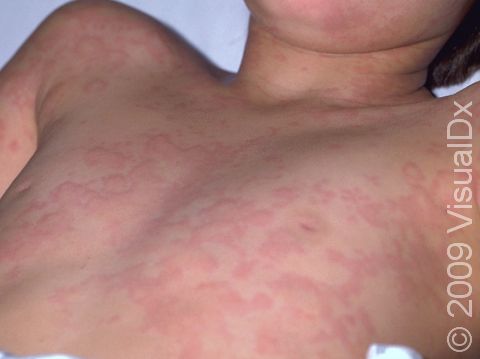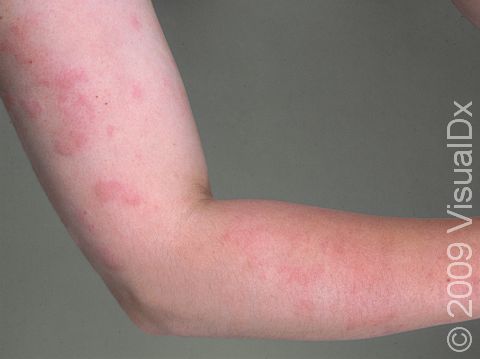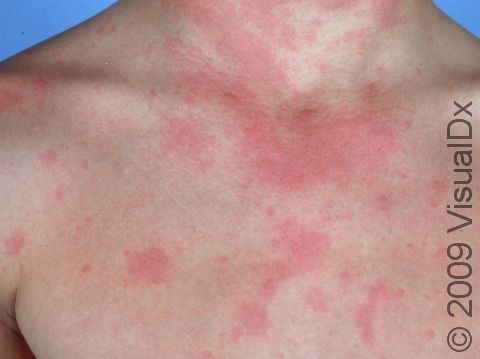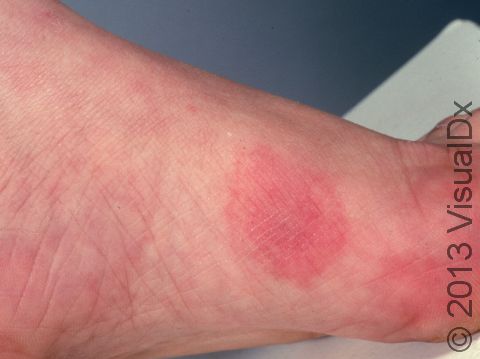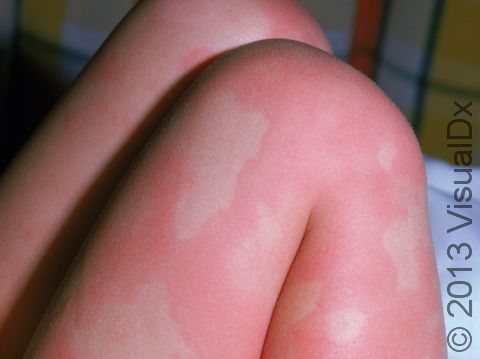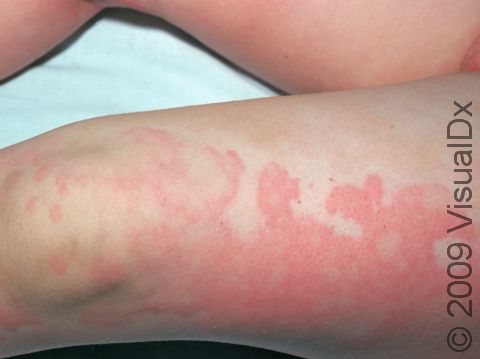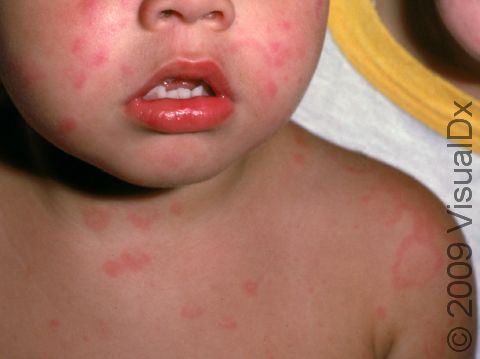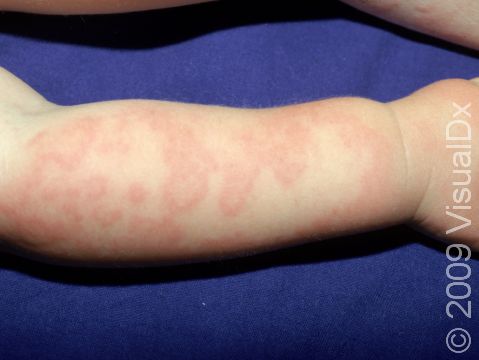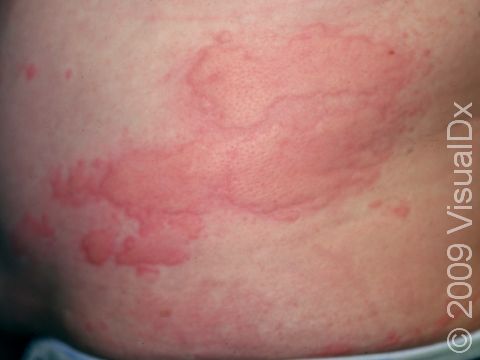Hives (Urticaria)
Hives (urticaria), also known as welts, is a common skin condition with itchy pink or red bumps (papules) that appear and disappear anywhere on the body. In darker skin colors, the redness may be harder to see, but the swollen skin bumps can be felt by the touch. An individual hive typically lasts a few hours before fading away, and new hives can appear as older areas disappear.
Hives can be considered acute (new or periodic episodes lasting less than 6 weeks) or chronic (periodic episodes lasting more than 6 weeks). Although many people have a single episode of acute hives that goes away within a few days to weeks, some may have chronic hives, periodic (recurrent) attacks of hives that come and go over a period of years.
Hives can have many triggers, including:
- Medications, especially aspirin, ibuprofen, naproxen, narcotic painkillers, and antibiotics.
- Infections with viruses, bacteria, and fungi.
- Environmental allergies such as insect bites, pollen, mold, and animal dander.
- Physical exposures such as heat, cold, water, sunlight, and pressure.
- Medical conditions such as gland diseases, blood diseases, and cancer.
- Food allergies such as to strawberries, eggs, nuts, and shellfish.
In up to 90% of outbreaks of hives, a trigger is never found, despite extensive testing; these cases are referred to as idiopathic urticaria. In approximately 50% of idiopathic urticaria outbreaks, hives are most likely caused by a reaction from the person’s own immune system (an autoimmune reaction).
Who's At Risk?
Hives appear in people of any age, race / ethnicity, and sex. Hives are very common; it is estimated that up to 20% of the population will develop hives at some point in their lives. Individuals with a family or personal history of atopic conditions (asthma, hay fever, eczema) are more prone to developing hives.
Acute hives are most common in children and young adults, and chronic hives are more often seen in females, especially middle-aged women.
Signs & Symptoms
The most common locations for hives include:
- The trunk.
- The upper arms or upper legs.
However, hives can affect any skin surface.
Individual hives appear as distinct (well-defined), pink-to-red swellings, which, in darker skin colors, may be easier to feel than see. The bumps range in size from 2 mm to over 30 cm. Some lesions may develop a lighter center. Hives usually appear in groups or batches.
Individual hives disappear within 24 hours, but a single episode may last much longer.
Dermographism is a type of hives that appears within a few minutes of scratching the skin. The rash usually appears in a straight line (linear) pattern.
Swelling of the eyes, mouth, hands, feet, or genitals can sometimes occur with hives. This swelling, called angioedema, usually goes away within 24 hours.
Hives are usually itchy, but they can also burn or sting.
Self-Care Guidelines
If your child is experiencing mild hives, you can try having them:
- Take cool showers or baths.
- Apply cool compresses.
- Wear loose-fitting clothes.
- Avoid strenuous activity.
- Use an over-the-counter antihistamine such as cetirizine (Zyrtec), fexofenadine (Allegra), loratadine (Claritin), or diphenhydramine (Benadryl).
In addition, try to discover and avoid any triggers of your child’s hives.
Treatments
After confirming that your child has hives, the medical professional will work with you and your child to discover the possible cause. They will also take a detailed medical history and may do blood tests.
The best treatment for hives is to discover any triggers and stop your child’s exposure to them. However, most people with hives do not know the cause and require medication to get rid of the hives.
The most common medications for hives include:
- Non-sleep-causing (nonsedating) antihistamines such as loratadine (Claritin) for ages 2 years and older, cetirizine (Zyrtec) for ages 2 years and older, fexofenadine (Allegra) for ages 6 months and older, or desloratadine (Clarinex, Aerius) for ages 6 months and older.
- Sleep-causing (sedating) antihistamines such as diphenhydramine (Benadryl) for ages 2 years and older or hydroxyzine (Vistaril, Atarax).
- Your physician may prescribe other antihistamine or anti-inflammatory medications.
These medicines should only be used as directed by a medical professional.
In rare situations, the medical professional might prescribe a short course of oral corticosteroid pills (a steroid). Other classes of oral or injectable medications may be prescribed for recurrent hives that do not respond to these measures.
Visit Urgency
If your child’s hives make it difficult to breathe or swallow or if your child feels lightheaded, call 911.
In nonurgent situations, see your child’s medical professional if the hives do not improve with treatment or if they continue to appear for more than a few days.
Before visiting your child’s medical professional, try to notice what might be triggering the hives and whether it improves or worsens with exposure to heat, cold, pressure, or vibration. Take a list of every medication (prescription and over the counter), supplement, and herbal remedy your child may have taken recently. Also consider any recent illnesses your child has had because some illnesses (and their treatments) can trigger hives.
Trusted Links
References
Bolognia J, Schaffer JV, Cerroni L. Dermatology. 4th ed. Philadelphia, PA: Elsevier; 2018.
James WD, Elston D, Treat JR, Rosenbach MA. Andrew’s Diseases of the Skin. 13th ed. Philadelphia, PA: Elsevier; 2019.
Kang S, Amagai M, Bruckner AL, et al. Fitzpatrick’s Dermatology. 9th ed. New York, NY: McGraw-Hill Education; 2019.
Paller A, Mancini A. Paller and Mancini: Hurwitz Clinical Pediatric Dermatology. 6th ed. St. Louis, MO: Elsevier; 2022.
Last modified on June 13th, 2024 at 11:57 am

Not sure what to look for?
Try our new Rash and Skin Condition Finder

